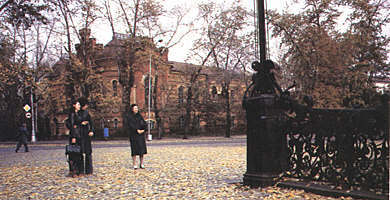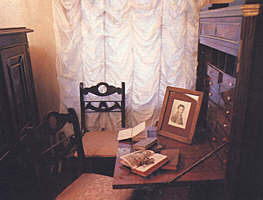![]()
Museums
![]()
Irkutsk regional museum is one of the oldest in Siberia and in Russia. It was opened in 1782 according to the initiative of the Irkutsk governor F.N.Klichka. The museum was supposed to collect natural subjects of the Siberian territory, models of agricultural instruments, tools, models of ships, which sail along the lake Baikal and the Pacific ocean shores. The museum organization was done by honorable member of the Academy of Sciences E.Laxman and correspondent of the Academy À.Ì.Karamyshev.
The two-storied building in the Mauritian style was constructed according to the project of the engineer – architect, baron G.V.Rosen in 1882-1883, 1890-1891.
On the building walls the surnames of the researchers of Siberia were imprinted: Bering, Steller, Gmelin, Pallas, Georgi, Miller, Wrangler, Ledebur, Humbolt, Middendorf, Krashennikov, Messershmidt, Maak, Maximovich, Nordenscheld, Turchaninov, Przhevalskii and Cherskii.
Now the museum has archeological collection, exceeding 300 thousand exhibits and representing monuments from the Paleolithic period up to the iron age. The first in Russia a Paleolithic monument "the Military hospital " was opened in Irkutsk in 1871. It was studied by V.A.Belzov, I.D.Cherskii and A.L.Chekanovskii. The brightest page in the Siberian archeology was the opening of the Paleolithic encampment Malta by Ì.Ì.Gerasimov on the White river in 1928.
Unique archeological materials were carved female small figures, animal images, ornament and reconstruction of the Paleolithic dwellings. They were included in the annals of the world archeology. In the 1880s N.I. Vitkovskii found and studied the Glazkovskii and Kitoiskii graves. The results of these works made a revolution in the views of modern scientists, who had thought, that there was no stone period in Siberia. Today the collection of the archeological “nephrite” is the largest one in Russia. These are ornaments and work instruments from white and green nephrite, making funeral stuff of the graves of the Stone and Bronze Ages.
The museum has extensive collections of the peoples of Siberia ethnography and cult subjects collection of shamanism and lamaism.

The exposition, reflecting the Priangarye history since February 1917, was placed as well. The birth of a new epoch was the same difficult and bloody for our territory, as for all the country. The remoteness of Siberia from the center, economic development peculiarities, prosperity of the peasants, specific social and national structure of the population, affinity of eastern borders determined local specificity: fierce struggle of parties, long establishment of the Soviet authority, intervention, the Kolchak regime, complexity of restoration of the economy.
In the Great Patriotic war years the Siberians rose up to protect the Fatherland together with the rest of the country. The industrial base of the area was considerably extended at the expense of the enterprises, evacuated from the western areas of the Soviet Union.
In the post-war period the development of natural resources of the region, rich minerals, water and wood reserves began. The industrial giants, railroads, cities were being constructed.
The exposition of the museum tells about it.
The history of people life of the territory during two centuries – the XIX and XX - is open through clothes, household subjects, utensils at the exhibition “Last (gone) century – the present century ". A range of shown exhibits - from ancient laces to TV and jeans.
The exhibition - interior "Epoch in interiors" give its visitors a direct dialogue with museum exhibits, a sense of time, contact with history.
Irkutsk regional art museum is one of the best and richest museums in Russia.
The beginning to the museum collection was put with the private picture gallery of a large public figure of Siberia, city head of Irkutsk, publisher and patron of the arts Vladimir Platonovich Sukachyov (1848-1920).
First Sukachyov’s collection of Russian artists canvases were acquired in St.-Petersburg in the early 1870s. By the end of the century the gallery had totaled more than 80 excellent works of Russian and West-European masters. V.Maximov and A.Bogolyubov, I.Repin and M.Klodt, P.Vereshagin and I.Aivazovskii, I.Welz, B.Willewalde, Y.Clever, L.Lagorio were shown for public.
"… A graceful picture gallery, … one of Siberian rarities, has pleasantly surprised me", - Jul Legar, a professor from France wrote.
V.P.Sukachyov bequeathed his picture collection to the native city.
Having become a basis of museum collection, the picture collection was nationalized in 1920. The merchants, gold-mine owners, bankers, public and official offices added other art works to the museum.
The exhibits of oriental collection were handed to the gallery from the museum of the Eastern-Siberian department of Russian geographical society.
The true treasures poured into the Irkutsk collection from the State museum fund in 1928. These were the works of F.Rokotov, V.Borovikovskii, I.Ivanov, I.Shishkin, V.Polenov, In.Serov, Í.Rerikh, A.Kuindji.
It was a good luck for the museum to get a picturesque canvas of I. Shebuev "Moses with the God’s stone planks", porcelain collections and jewelry products of the Faberge firm, valuable collections of the oriental art.
A rich collection of a senator N.Erakov belongs to a number of happy acquisitions: daos deities sculptures, ancient Russian art silver, rare monuments from stone and partitioned enamel of China, picturesque canvases of S. Dofen, P. Patter, Å. Lansere’s sculpture …
The museum became the owner of two porcelain icon-stands of the late of the XIX centuries. The analogues of these icon-stands are not present in any other museums of our country.
The influx of cultural monuments in 1948-1949 was significant through the committee of arts at the Ministerial Council of Russia and the USSR.
The special place in the museum collection is taken with the products, gifted by large collectors and those, for whom the given stuff were unique and valuable relic. More than a hundred givers have left their names in archives and expositions of the museum. The museum continues forming its collection.
One of the strongest creative associations is the Irkutsk branch of the Union of artists of Russia - has been contributing to the development of the homeland art. The names of the artists are widely known. A.Alexeev and B.Bychkov, A.Vychugzhanin and A.Zhibinov, V.Rogal and V.Smagin. It is difficult to mention everybody. Their works entered harmoniously the best collections of Russia.
Since 1995 the museum has been carrying a name of its founder. In October 1999 on the museum building the memorial plank, dedicated to V.P.Sukachyov was put.
The architectural - the ethnographic museum "Taltzy" was founded in 1966 for preservation of unique monuments of the Russian wooden architecture of the XVII - XIX centuries. The organizers of a museum were a historian V.V.Svinin and a Moscow architect G.G.Oranskaya.
The museum had its first visitors in 1980. For these years the museum "Taltzy" was visited by more than one million tourists from all the world.
The museum is located in a picturesque place on the right bank of the Angara river in the Talzy area on the 47th kilometer of the Baikal tract from Irkutsk to the lake Baikal.
The museum is famous for its rich natural landscapes and an opportunity of acquaintance with the materials and spiritual culture of the Pribaikalye peoples – the Russians, the Buryats, the Evenks.
The museum expositions tell us about life and life features, customs and traditions of the Pribaikalye peoples of the XIX – early XX centuries. The specific and majestic Siberian national architecture draws attention of tourists.
Traditional Russian national holidays, causing interest for visitors and Irkutsk area inhabitants, are organized there for many years in a museum. Mass festivals, games with participation of the best folklore collectives, masters and handicraftsmen of the city and area are held on Christmas, Saint days (between Christmas and Epiphany), Shrovetide, Trinity, a Holiday of crafts.
The potter’s and birch crafts are reconstructed in the museum. The visitors can model in clay small "masterpiece" ,using their own hands, and can take it with themselves as the memory of the museum.
The museum employees have research work on the culture of the Pribaikalye peoples. The results are published in a magazine "Taltzy", which has been issued in the museum since 1988. It is the only one periodic edition of such kind in Russia.
In 1999 the decision of the Ministry of culture of Russian Federation assigned the museum to become a methodical centre of the architectural - ethnographic museums of Siberia and the Far East.
On December 29, 1970 a museum of the Decembrists – the branch of the Irkutsk state combined museum- was opened in the house of the Trubezkois.

The house - museum plays an outstanding role in cultural life of the city. After its opening a perfect tradition - organization of musical-literary evenings and home performances came back. Their sources date back to cultural traditions of the families of the Volkonskiis and Trubezkois. The meetings with well- known writers, artists, actors, musicians in a drawing room of Trubezkoi became integral part of Irkutsk literary, theatrical and musical life.
The original things of the Trubezkois are kept in the museum: chairs, a landscape of A.S.Rebinder’s brush, embroidery of E.I.Trubezkaya, bronze table, vase and others.
In October 1999 the Museum became independent and it is called now as the Irkutsk regional historical-memorial museum of the Decembrists. The museum became the work of the whole life for its unchangeable director Eugenie Alexandrovich Yachmenyov.
The museum of the Irkutsk city history was opened in January 1996.
The basic tasks of the museum are preservation, popularization of the historical-cultural heritage of the city; patriotic and moral education of the young citizens of Irkutsk.
The museum carries out research, exposition-exhibition, collection, guardian, cultural - educational, scientific - propaganda and publishing work.
The museum promotes development of national crafts, propagandizing the history and culture of Irkutsk.
The Club "Meeting" ("Memorial"), club of the Honorable citizens of the city Irkutsk, circle "Young regional historian", urban regional history club of "Irkutsk – Fort-Ross" work at the museum.
![]()
Public reproduction of materials of this site or
separate parts, including electronic form,
admitted only with concent of Scientific Library of Irkutsk State
University.
© Copyright Scientific Library of Irkutsk State
University, 1999-2000
Webmaster Boris G.Fominyh
![]()